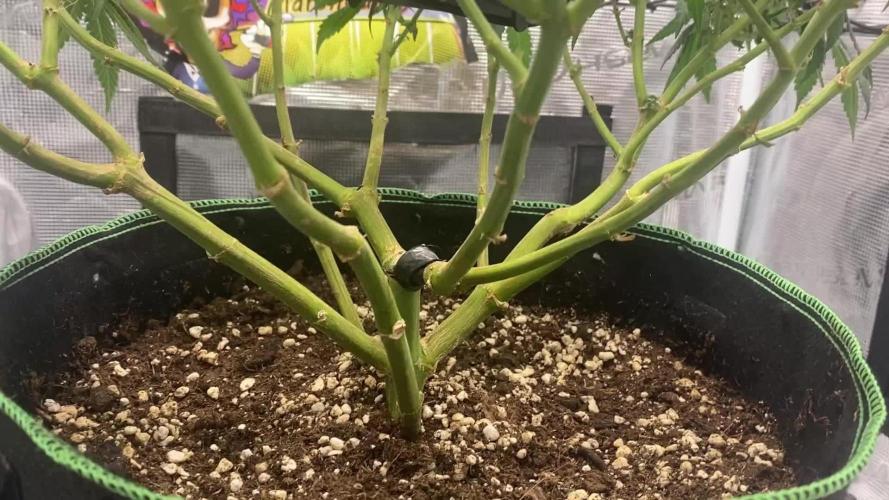The Grow Awards 2026 🏆 































Likes
Comments
Share


@GrowX420
Follow
Die Purple Lemonade FastFlower steckt aktuell ihre ganze Power in ihre Buds. Sie sieht einfach Mega geil aus, jedesmal wenn ich ins Zelt schaue, fasziniert sie mich 💚
Infos:
Gießwasser: 1L in 24 Stunden
PH-Wert: 6.3
Nährstoffe/Dünger:
S&R Organics 5in1 4ml/1L
Vegan Phosphor Boost 6g
Luftfeuchtigkeit: 50-55%
Temperatur im Zelt: 20-23Grad
Lichtdauer: 12 Stunden
PPFD: 730-790
EQUIPMENT:
Licht🌞: Marshydro TSW2000 300watt ✅️
Rohrventilator💨: S&P TD 350 silent.✅️
Aktivkohlefilter💢: Can-lite 300
Zelt⛺️: Marshydro 80x80x160 ✅
Luftbefeuchter: Spider Farmer 6L. ✅️
Wenn ihr coole Genetiken kaufen wollt, schaut mal bei FastBuds vorbei🏆
Da findet ihr sicher was ihr braucht
Und wenn ihr parallel noch meine Arbeit unterstützen möchtet und gleichzeitig Geld sparen wollt
Benutzt meinen Promocode GROWX für 15% off auf euren gesamten Warenkorb
👉🏻GROWX
Likes
39
Share


@Siriuz
Follow
Happy growing everyone
Thank you so much sweet seeds
We promise and we are here to show you
Stay tuned because we just started
And she will grow beautiful indeed
Best of luck to all growers in their journey
DAY 1
TO
DAY 3 THEY FINALLY SPROUT
FIRST COTYLEDON SHOWING
DAY 4
TO
DAY 5
HAD TO MOVE HER TO A BIGGER POT DUE
TO TAPROOT COMING OUT OF PEAT MOSS
Processing
Likes
19
Share


@Mission420
Follow
This week things seem to be progressing normally. Although not knowing what to expect, I can't say for sure, but no mishaps so far. I think they have stopped stretching, and are starting to get bigger buds, but that may be wishful thinking.
Watching the time lapse I am noticing that during certain parts of the day, the leaves are drooping still. At first I manually turned on the pump for their nutrients when I saw the leaves starting to sag, which was generally when I got up in the morning, but then watching the video, I decided to start doing it earlier. After watching last weeks video, I decided to set the pump to go on even earlier, and now I think I might do earlier still, or even perhaps set it to run twice a day. Time will tell... literally.. 😃
As you can see, I dropped the amount of Medi One this week, and upped the Bloom formulation with no big change in the results that I can see, but they do look healthy with green leaves and no unusual tips.
Likes
3
Share


@NYGROW
Follow
Blue dream is fading yellow she wants to finish even tho buds still with plenty white pistils and I think they can get bigger hopefully she’s able to stay strong one more week .. purple lemonade just starting to fill the buds I believe she has a couple weeks left
Likes
21
Share


@w33dhawk
Follow
Moin ihr growmies, ich hatte diese Woche kaum Zeit was zu machen ausser ein wenig lst und Blätter entfernen Bilder hab ich auch kaum Zeit für gehabt bin aber zufrieden mit dem Fortschritt ich denke mal noch so 2 bis 3 Wochen dann stelle ich auf 12/12 um........
Likes
422
Share


@Crashoverite
Follow
Hi everyone.
Welcome to my🍌💜👊 week update.
Hope everyone keeping well and having a great week.
Daily updates and uploads so if week not over yet. Please revisit to see full week content😊
Thank you all for such amazing support 😊🤗💜
So far everything is going great. No issues at all. Both girls started preflower on Tuesday and already I can see that they started stretching nicely. Scrog net will be installed by the end of this week.
Week 5
13-19 Nov.
13/11 day 36
First runoff experience for girls. Loaded both pots with approx. 2.5 ltr each in 4 stages of 500-700ml. Runoff 100-150ml from each. Runoff PH 5.9. Nutrients for this watering were same as on previous week and added only calmag. Next watering possibly Friday but with new measurements.
14/11 day 37
Both 🍌💜👊 girls started preflower on same day. Xena is catching up quick to her larger sister and possibly soon they will be sharing this growing space 50/50
15-16/11 days 38-39
Just happy and healthy days 😁 nice steady growth.
17/11 day 40
Second watering for this week. 5.5l beetwen both. Runoff Ph 6.1
19/11 day 42
Most busiest day so far. Both girls got very bushy in last few days and they stretched enough to install scrog net. Before installing net applied selective defoliation on both girls. 8-10 fan leaves from each.
It's the end of this amazing week 😁
Thank you all again for such a great support 🤗✌️💚
Likes
68
Share


@Hawkbo
Follow
This is what's left pics were taken last thurs. Got like 8 more left to chop this week then when they're all down and I got pics ill do the harvest update
Likes
13
Share


@SwabianMadness
Follow
Things get real crazy here 😉😎 just 3 Weeks left to the original Date from Breeder. I be so curious if the Buds get more Volume at this Time
Give them last Dose of the PK5/8. 20ml in 1 Liter for every one. Now they just become Water til the harvest Day. Eventually i flush them at the End. Depends on what the Leaves look like
What do you think to take a few more leaves for the Buds down under? Or is it to much stress?
Have the FC3000Evo 40cm from the Top since Flower Week 3. I‘m trying to get to 30cm now. Maybe they like it and gets more voluminous
Likes
10
Share


@Hoso_sake1
Follow
Seconda settimana di vita delle nostre Strawberry Pie di Fastbuds!
Continuiamo a mantenere l'umidità relativa abbastanza alta 50-60% per permettere alle plantule di svilupparsi al meglio, senza però farle prendere troppo freddo!
Tra qualche giorno potremo procedere anche al prossimo passo: Dare i nutrimenti necessari per permetterle di crescere sane e forti per le prossime tre settimane di crescita.
😎
Likes
12
Share


@Kirsten
Follow
9.2.25:
The plants had a good watering, they're all still drinking a lot. Which is great, as that means growth, which, at this stage, we desperately need!
I went ahead and gave all the plants a thorough watering each with:
2ltrs of dechlorinated water, PH'd to 6.5 with:-
♡ 4ml of Xpert Nutrients Bloom Booster
♡ 4ml of Xpert Nutrients Cal-Mag amino acids
♡ 4ml Seaweed extract liquid
I don't know how this scrog net is going to work out.
I think the squares are too big. It's elasticated, which I like. However, I'm extremely cautious with watering and moving the net. It's only a matter of time before I break more branches. It's such a hassle with it in there, honestly. I can't get in the tent properly to even check the weight of pots, as it's all weaved through, and again, I will snap branches.
I did have a free net with the tent, which I think was smaller squares. I think I will use some other training next run.
It's really not my kind of setup. I'm too interested in moving things and inspecting the plants constantly.
The net is driving me up the wall. 😣 I'm considering removing it and trying something else, but it's also a bit too late for oldest plants.9.2.25:
Gave the plants another good soak.
I used 2ltrs of dechlorinated water PH'd to 6.4. It contained the following nutrients;
♡ 4ml of Xpert Nutrients Bloom Booster
♡ 4ml of Xpert Nutrients Cal-Mag amino acids
♡ 4ml Seaweed extract liquid
♡ 0.5g of Ecothrive Biosys.
The plants are undergoing explosive growth at this stage, which I'm thrilled by!
Purple Lemonade is turning purplish hues.
Pink Mist has so many bud sites and is looking very healthy.
Do-sì-dos is growing vigorously and looking promising, especially considering all my unfortunate mishaps! 😅
Watermelon also has considerable growth. However, my training has made a mess out of the structure. Which I consider another valuable take away.
Bubble
Likes
3
Share


@cmstacker01
Follow
Dense nuggets, identical plants.
Pretty easy to trim. Don't think this species is really fungus prone,small buds but very dense.
Will update smoke report later.
Need to cure now at least 4 weeks.
Will post and update in september.
Likes
22
Share


@fungrow
Follow
week 9 budding is complete and took#1 after 9weeks,1 day...the other2 in may be a week...harvest pics next week
Likes
Comments
Share


@Lushgaia
Follow
Some of the leaves starting to yellow slightly but as it’s coming to the end I think I will let it ride out might give a little pk booster but that’s about it
Likes
13
Share


@Canadian
Follow
By the looks of things they seem to have between two and three weeks to go. so from now on no nutrients will be added to the water only water at 6.5 pH the plant has recover great and very well from the nutrient lockout and the buds are getting bigger the smell is strong and very nice. Probably next week I want to defoliant more in order to allow the light to penetrate better in the lower parts of the plant and then get more mature buds in the bottom of the plant.
thank you for reading I will continue to update have a happy grow
Likes
72
Share


@BodyByVio
Follow
Day 65 : officially 1st day of flush . Changed the reservoir with fresh water and 1.2g/5 gallons of Yucca extract and 5ml/gallon of Cleanex from Botanicare .
Day 68- I did some defoliate. Few more days until harvest.
Processing
Likes
1
Share


@nausicaahime
Follow
week 7
first flowering week
when I finally discovered my princess was actually a prince.
12/12
flowermind ferts (6ml + 0.5g)
LST + defoliation
started seeing some thrips again, but just a few, nothing to worry
so, the plant stayed for 4 weeks in the tent, under COB LED 200W.

























